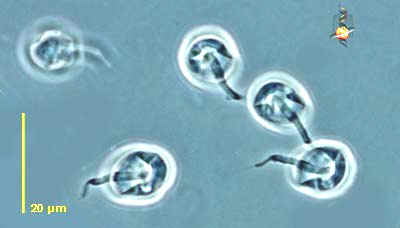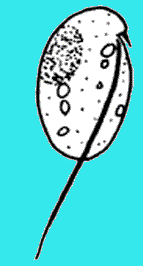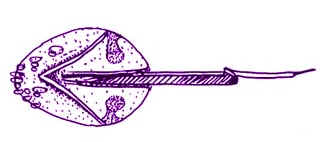
| Palaeos: |  |
Stem Metazoa |
| EUKARYA | Apusomonadida |
| Page Back | Unit Back | Unit Home | References | Glossary | Pieces |
| Page Next | Unit Next | Eukarya | Dendrogram | Taxon Index | Time |
STEM METAZOA |--Apusomonadida | |--Amastigomonas | `--Apusomonas `--+--Amoebozoa `--+--Microsporidia `--+--FUNGI `--METAZOA |
Apusomonadida Amastigomonas Apusomonas References |
 Apusomonadida:
may be synonymous with Thecomonadea and the genus Amastigomonas.
Apusomonadida:
may be synonymous with Thecomonadea and the genus Amastigomonas.
Range: cosmopolitan in marine & fresh waters, also present in some soils. Very common, but rarely numerous. Diversity is quite limited. No fossil record.
Phylogeny: * : Amastigomonas + Apusomonas (but see note on phylogeny below).
Characters: General: There's no sense in trying to get too fancy about the Apusomonads. There are only two genera, Amastigomonas and Apusomonas. These genera contain less than twenty species, and perhaps half that [P99]. They aren't all that complicated. The Apusomonads may also be related to Ancyromonas, with which they are said to constitute the Apusozoa. See, e.g., [CC03]. Apusomonads are small, free-living, gliding cells with two flagella. They are tectic, i.e. living on the surface of particles, sediment, or other creatures both in soils and in fresh or salt water. They appear to have particular importance in nearshore marine and brackish sediments. Dorsally, they are covered by an external, organic theca. Ventrally, they extrude pseudopodia which they use to capture and ingest bacteria. [P99].
Peripheral structures: The theca covers basal part of anterior flagellum and may appear as an anterior mastigiophore or even as a collar [CS95]. However, this structure is not made up of microvilli as in choanoflagellates. The theca is observed as dense layer ?adjacent to or ?within the plasma membrane [CS95] [CS03]. The theca is organic and flexible [PZ91].
Membranes: The ventral surface has no covering. Its surface bears a groove (or two lateral grooves [PZ91]) with prominent lips [CS95]. Pseudopodia (infra) emerge from these lips [CS95]. The pseudopodia are produced from morphologically ordinary plasma membrane, without the extrusosomes found in, for example, Ancyromonas [CS03] (but see zooeng3_99p383abs).
Motility organs: Two flagella, the anterior (or anterolateral) one of which is covered proximally by the theca. In many preparations, the anterior flagellum seems to arise from a mastigiophore [CS95]. The other flagellum is posterior and lies in the ventral groove [CS95]. The two basal bodies insert almost at right angles and give rise to four microtubular roots, two of which determine the margins of the ventral face of the cell. [P99].
Mitochondria: tubular cristae [PZ91].
Nuclei: considerable amounts of condensed chromatin (unusual for protozoa) [CS03].
Phylogeny: As noted above, the Apusomonads may be related to Ancyromonas, another bicilliate free-living heterotrophic monad with a similar theca and with flagellar bases also meeting at right angles. However, Ancyromonas differs in important ways. For example, its mitochondrial cristae are flat. There is no significant evidence that the "Apusozoa" are a clade, although they may represent successive surviving branches from the trunk of the eukaryote tree. Cavalier-Smith & Chao [CS03] believe that the Apusozoa derived very early, and, even in our preferred phylogeny, these taxa would fall below near the base of the deep branch leading to the opisthokonts (animals and Fungi) and the Amoebozoa. We may then suppose, for example, that the ancestral form was a monad with a with a theca which, in some progeny, assumed the form found in the Apusozoa. In the apusomonad lineage, the theca opened up ventrally to allow the formation of pseudopodia which, in turn, led to the abandonment of the theca in the Amoebozoa. In the opisthokonts, the cell membrane area requiring dorsal protection might have been minimized instead by assuming a colonial form, with only the outer cells producing an integument -- i.e. to the evolution of Metazoa and Fungi. That's rank speculation, of course, but the fact that that we can tell a sensible story suggests that we may be on the right track and that we may find a testable hypothesis in that direction.
Among the Apusomonads, Amastigomonas is much older and is probably paraphyletic by rDNA [CS03]. That is, all species of Apusomonas are actually species of Amastigomonas. In that case, the genus Apusomonas should be abandoned, although there seems little chance of that happening.
Image: Apusomonas from Microscope
Links: Apusomonads (ToL); zooeng3_99p383abs (abstract).
References: Cavalier-Smith & Chao (1995) [CS95]; Cavalier-Smith & Chao (2003) [CS03]; Patterson(1999) [P99]; Patterson & Zölffel (1991) [PZ91]. ATW030526.
 Amastigomonas:
deSaedeleer 1931 (= Thecamonas). A. debruynei
deSaedeleer 1931.
Amastigomonas:
deSaedeleer 1931 (= Thecamonas). A. debruynei
deSaedeleer 1931.
Range: as for the parent. Mostly marine, but some soil and fresh water. No fossil record.
Phylogeny: Apusomonadida: Apusomonas + *.
Characters: No synapomorphies -- probably parent of Apusomonas. Biflagellate gliding protist, flagella insert subapically and to one side, dorsal surface of the body is covered with a thin organic theca, and the ventral surface produces pseudopodia. Anterior flagellum is enclosed basally or completely by the theca. Posterior flagellum trails under the body, both flagella may be very difficult to see. From marine and freshwater sites. [PZ91].
Image: from Microscope, based on a drawing provided by Won Je Lee.
Links: Amastigomonas De Saedeleer, 1931 (ToL); Genus Amastigomonas - Details - Systema Naturae 2000; Taxonomy browser (Amastigomonas); zooeng3_99p383abs.
References: Patterson & Zölffel (1991) [PZ91]. ATW030526.
 Apusomonas:
Aléxéieff 1924 (= Rostromonas). A. proboscidea
Aléxéieff, 1924; A. australiensis Ekelund & Patterson, 1997.
Apusomonas:
Aléxéieff 1924 (= Rostromonas). A. proboscidea
Aléxéieff, 1924; A. australiensis Ekelund & Patterson, 1997.
Range: No fossil record.
Phylogeny: Apusomonadida: Amastigomonas + *.
Characters: Cells 4-12 µ long and flattened. Gliding flagellates in which the anterior flagellum emerges from a projecting mastigiophore [PZ91]. The mastigophore emerges from a cavity about two thirds of the cell length from the anterior end, is highly flexible and may be withdrawn into the sheath when the cell is stressed. There are two flagella, one bearing an acronema, and both insert near the projecting end of the mastigophore [PZ91]. The second flagellum runs backwards to lie under the cell and usually cannot be seen [PZ91]. The mastigophore beats slowly as the cell moves [PZ91]. Species in this genus eat bacteria, with the food being ingested taken ventrally [PZ91]. The nucleus is located posteriorly [K+00]. Temporary cysts may be formed, and the genus is cryptobiotic [PZ91]. The genus is common in soils (world-wide) and has also been reported from fresh-waters [PZ91].
Links: Apusomonas Aléxéieff, 1924 (ToL); Apusomonas (NCBI).
References: Patterson & Zölffel (1991) [PZ91]. ATW030526.
| Page Back | Page Top | Unit Home | Page Next |